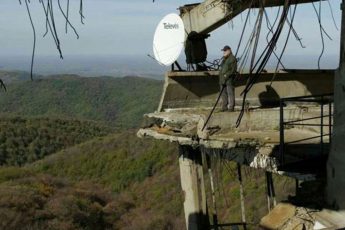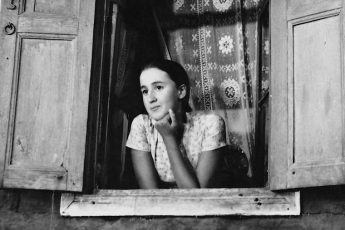Introduction – DAY 1 – A Grain of Truth – Body
Gdynia 2015
Vol. 57 (September 2015) by Rohan Crickmar
The Gdynia Film Festival is the major national film festival for Polish Cinema and is supported by Poland’s Ministry of Culture and National Heritage, the Mayor of Gdynia, local politician Mieczysław Struk, the Polish Filmmaker’s Association and, most crucially, the Polish Film Institute. HBO and TVP are the major media organizations involved in promoting the festival, which is partly why there are programmed slots for television series premieres, such as this year’s David Simon vehicle Show Me a Hero. The 2015 edition of the festival is also the 40th anniversary edition, as well as marking the 10th anniversary of the formation of the Polish Film Institute. The latter national organization has been fully rewarded for its pursuit of fostering film education, film development, new filmmaking talent, and supporting established names, because in 2015 alone Polish films have won awards at Berlin, Locarno and Venice, as well as the nation’s first feature film Oscar. 2015 also marks the opening of the Gdynia Film Center, which is a new purpose built structure, beside the Teatr Muzyczny on Plac Grunwaldzki, that now serves as the new festival hub. This infrastructure development has enabled the 40th edition of the festival to ensure almost all of its major screenings and events occur within locations around the central waterside areas of the city’s downtown.
This is my second Gdynia Film Festival, having been invited to attend last year’s event, by the then newly appointed artistic director Michał Oleszczyk. Last year’s festival featured a number of intriguing debut features (Hardkor Disko, Little Crushes), as well as big budget releases, in Polish film industry terms, such as Jack Strong and Warsaw 44. My impression then was that 2014 was a particularly strong year for Polish cinema. This year’s festival, however, features internationally acclaimed festival films from veteran filmmaker Jerzy Skolimowski and critical darling Małgorzata Szumowska. In total there are 18 films in the Main Competition (Konkurs Głowny) this year. Michał Oleszczyk has also created a new competition strand for challenging and offbeat new Polish films, called the Visions Apart Competition (Konkurs Inne Spojrzenie). This latter strand boasts six features in competition and is something akin to the Un Certain Regard section at Cannes. There are also further competition strands in the form of the Young Cinema Competition (Konkurs Młodego Kina) and the Short Film Competition (Konkurs Fabularnych Filmów Krótkometrażowych).
Alongside the various competition programs there is the return of the Pure Classics (Czysta Klasyka) strand, which proved successful last year and seeks to rediscover forgotten gems from Polish cinema’s past. A particular highlight this year for myself is the promotion of the late Walerian Borowczyk’s sole Polish feature film, the unfairly maligned Dzieje Grzechu. There is also a mini-program of Pre-War Polish Cinema (Skarby Kina Przedwojennego), as well as a strand entitled Code Name Murder – Militia Films (Kryptonim MOrd – Filmy Milicyjne) which looks at a sub-genre of crime film that was popular in the Polish film industry of the 1960s and 1970s. Over the next five days I will be reporting on films featured in most of these sections, as well as press conferences and media events connected with them.
DAY 1 (14.09.2015): A Grain of Truth – Body
The first day featured the opening ceremony of both the Short Film Competition and the Festival itself. It also featured the screening of five films from the Main Competition and five films from the Visions Apart Competition. The Opening Gala event of the festival took place at the large Teatr Muzyczny auditorium, as was the case last year, at 7pm. After this event there was a party held at the nearby Mercure Hotel. I was unable to attend the Opening Gala due to a mix up with my festival registration, however I was still able to see two of the Main Competition screenings, one at either end of the day.
The festival opened with a metaphorical bang in the form of Borys Lankosz’s follow up to the 2009 award-winner Reverse. This new feature was called A Grain of Truth (Ziarno Prawdy) and it revealed a certain cunning in the program scheduling. I attended the GCF Sala Goplana screening, which enabled me to have a first experience of the new Gdynia Film Center. Sala Goplana is a small screen on the basement floor of the building, that was perhaps two-thirds full. The quality of the projected image on this screen was as good as I have witnessed at any festival. The film was simultaneously being shown on two larger screens in Gdynia’s multiplex cinema Multikino, as well as a special press screening (followed by press conference) in the GCF’s larger Sala Warszawa. As with last year these early morning screenings began at 8:45am meaning that those people arriving early on Monday morning had only ten minutes to orient themselves at the GCF, as the festival offices did not open before 8:30am. This was a minor hiccup in an otherwise well-organized first day’s schedule.
Now why was A Grain of Truth such an incendiary opening feature for the festival? In part this was down to Lankosz’s meticulously modern sentiments. However, a significant part was also played by the fact that this was a genre film and a novel adaptation, starring one of Polish cinema’s most recognizable faces Robert Więckiewicz. The film’s source material is a novel of the same name by Zygmunt Miłoszewski, who is that rarest of things in Polish literature, namely a crime writer. Miłoszewski worked with director Lankosz on the screenplay. Together they have helped to craft a slightly parodic take on recent crime fiction trends (Scandi-Noir and Supernatural Detective Fiction).
Borys Lankosz is very clearly a modern Polish filmmaker. In Reverse (Rewers) he established and then cultivated a signature filmmaking style, or formula, which utilizes genre to interrogate the more unsavory aspects of Polish history. Alongside this use of genre, Lankosz also seeks to appeal toward what may pejoratively be described as ‘cosmopolitan sentiment’ by those right-wing, patriotic, Catholic Poles who are ultimately the butt of this film’s joke. This is a director who cannot resist reinforcing his progressivist stance with a final narrative move that simultaneously damns the church, the Communist past and the present patriotic nationalist reactionism. Most shockingly the film tackles head-on the mythos that makes antisemitism possible in a country like Poland, and it does so in a manner that initially seems anti-Semitic itself.
The stunning animated opening credit sequence maps out a nexus of blooded roots or veins connecting together various stereotyped representations of Judaism, or, more broadly, ‘orientalism’. From hooked-nose money lenders this sequence accelerates into the nightmarish terrain of ritual slaughter and the blood-letting sacrifice of infant children. It is a powerful and provocative encapsulation of the core idea of the film, that such myths and legends have an ability to evoke deep-rooted prejudices, born out of religious and social intolerance. At one point in the film a character acknowledges that ‘evil is the result of gossip’, and the opening credits present us with malicious gossip that will lead to malignant evil.
The film follows the investigations of a Warszawa prosecutor, played by Więckiewicz, who has separated from his wife and family and sought out a new life in the provincial south-eastern Polish town of Sandomierz. This prosecutor, Teodor Szacki, is investigating a series of grisly crimes that seem to be referencing the notorious blood libel accusations levelled against the Jewish population of Sandomierz in previous centuries. This accusation of blood libel is even given some credence by its depiction in a religious painting that is hidden from view within the town’s cathedral. Szacki, as an outsider, is able to look at the case with a fresh pair of eyes, seeing the ‘blood libel’ myths for what they are, and all too aware of the anti-Semitic hatred present within many of the townsfolk.
The film is fascinating as a genre piece because it manages to prove its genre self-awareness without necessarily lessening its overall effect. Magdalena Walach’s character Barbara Sobieraj, who assists Szacki in his investigations, is presented in a manner reminiscent of recent emotionally dysfunctional female investigators in Scandi-Noir series like Forbrydelsen and Bron. In one hilariously incongruous sequence Więckiewicz and Walach reverse the gender roles of the infamous police interrogation scene in Basic Instinct. Much of Szacki’s investigation relies on the kind of puzzle-solving, bible-referencing nonsense beloved of Dan Brown and his ilk. There is also a truly ridiculous cameo turn from Arkadiusz Jakubik, a frequent Więckiewicz foil, as an ‘expert’ in cutting tools and weapons. All of these genre tropes are overtly and playfully mocked by the director and writer. At the same time though the relentless pacing – the editing is frequently as sharp as one of the many cutting blades present in the film – builds a frenzied, ferocious, hysterical energy within the film, barely allowing the viewer time to get their bearings before they are whisked off to the next locale. The crime scenes are coldly staged encounters with Grand Guignol horror, immediately suggestive of recent US psychological horror detective shows like Hannibal and the first season of True Detective.
In Reverse Lankosz also deployed a modern sensibility to examine a past period, in that case the Communist period of the 1950s. That modern sensibility revealed itself in the blending together of the pseudo-historical crime drama, with blackly comic and subversive elements, often derived from the dynamic stylishness of the film itself. A Grain of Truth sees the director and Lucas Bielan (his DOP) come up with kinetic, highly mobile, but still formally framed, camerawork that is forever scanning over surfaces or closing in upon faces, or bodies, as if scrutinizing them for secret details. This camera style also enables Lankosz and Miłowszewski to have a degree of fun with narrative bluffs, particularly in the final POV sequence that obscures the identity of the killer for an absurd length of time.
Black comedy is also at the fore of the strident anti-clericalism that forms the bulwark of the film’s assault upon the preposterousness of anti-Semitic myths and legends. The Catholic church in Sandomierz is shown as a cartoonishly austere and deathly place, with ghoulish staff and a forbidding atmosphere of intolerance. Miłowszewski’s cynicism regarding provincial Poland comes to the fore in a wonderful scene in which an academic discusses the word “żółć” (roughly translating as bile) as the most Polish of words, as not only does it solely feature accented letters that exclusively belong to the Polish alphabet, but it also excellently describes the characteristic that is most prevalent within the Polish psyche, an ever-accumulating hatred and disgust that one’s insides eventually drown in.
Ultimately, despite the film’s boldness and mischief, it doesn’t quite avoid the problem of derivativeness that has dogged many recent Polish genre films. Więckiewicz’s character is a typically Polish male character, redeemed by the martyring of female supporting characters. Some of the narrative leaps forward are a little too focused upon cheap laugh, rather than any extra sense of intrigue. The film does end upon a rather effective visual metaphor, using the repetition of a mysterious piece of CCTV footage that seems to depict an archaic orthodox Jew walking past the Jewish cemetery. In this closing shot the ghostly apparition disappears back into the obfuscatory mists of obscure mythology, a riddle solved but not necessarily resolved.
The overlaps between this opening film and Małgorzata Szumowska’s latest Body (Ciało), are too striking to have been left purely to chance scheduling. The Gdynia programmers have clearly done a rigorous job with the grand theme of this opening day. Janusz Gajos plays yet another prosecutor, but this time he is a widower and is struggling to look after his anorexic/bulimic daughter. Szumowska’s film is also supernaturally tinged, with a rather spiky sense of the absurd and a degree of formal sophistication in keeping with her previous films. It’s an award-winning production, having lifted the Silver Bear in Berlin, and is probably the most consistently intriguing of her films, thus far. The title alone shows precisely where Szumowska wishes to position herself as a filmmaker; Polish but with international pretensions.
The film begins and ends with cliche bound up in humor. Starting with a suicide, only to unravel that cliche with an unnerving bit of black comedy, the film then reverses this dynamic by turning a moment of mischief into sun-drenched and saccharine sentimentality. Both of these sequences demand that the audience seriously question what they have seen. The former seems to suggest that the dead are still walking among us; a narrative idea that plays a mutable role throughout the film. The latter sequence is seemingly much more mundane and straightforward, but the final long shot of the apartment window is a mystery, as one character is bizarrely absented from it.
Szumowska, writing with her DOP Michał Englert, shows a degree of narrative restraint and economy that has rarely been seen in her early works, although her formal sophistication has always hinted at such possibilities. The film is idiosyncratic, particularly in the manner with which it portrays the psychiatrist Anna, played with disarming pep by Maja Ostaszewska, but it is also far more focused than a film like Elles and benefits from strong performances by Gajos and Ostaszewska.
A theme emerges between the two films, namely the body and its materiality. Part of A Grain of Truth’s Grand Guignol horror is the manner in which the dead body is displayed coldly, clinically and in a sundered or rended state. Although Więckewicz’s prosecutor is ultimately trying to find where the bodies are being buried, the body itself is a secondary concern to the struggle over history and its meanings. In Body the body is the object, but the subject is what remains once that material entity, that porous carapace, has begun to degrade and decompose.
One of the truly arresting aspects of the film are the many bodies that Szumowska displays, an absolute cross-section of different Polish body forms. This reaches its zenith in a tremendous sequence in which Gajos’s prosecutor lies upon the bed and is haunted by the memory of his wife dancing semi-nude, in a raucous and carefree manner. Fear is what is being confronted by these unflinching and voyeuristic presentations of bodies: fear of aging, fear of suicide, fear of fatness, fear of infirmity. It is telling that one of the few bodies that is never displayed in the film, is the body of the infant that has been dismembered in a toilet stall. Here there is nothing to be scared of, just the numbing sense of the horrific, and it is that very sense that makes both of the male prosecutors in today’s films seem haggard and weary with life.




Leave a Comment